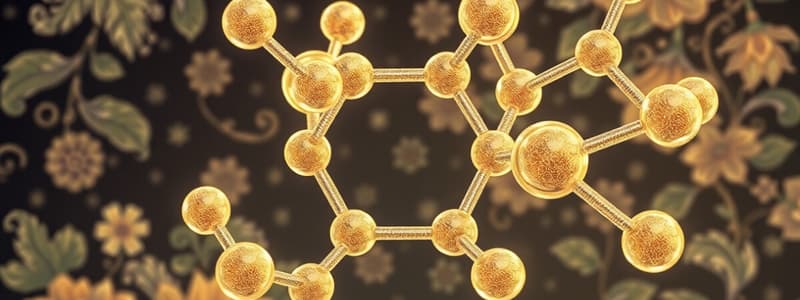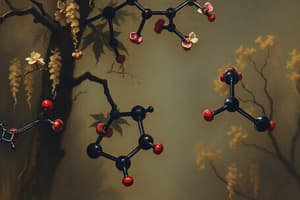Podcast
Questions and Answers
What is the empirical formula of benzene?
What is the empirical formula of benzene?
- C6H6 (correct)
- C6H10
- C7H6
- C5H5
Kekulé's structure of benzene accurately predicts its reactivity with reactions involving Br2.
Kekulé's structure of benzene accurately predicts its reactivity with reactions involving Br2.
False (B)
Who isolated benzene, and in what year?
Who isolated benzene, and in what year?
Michael Faraday, 1825
The unique stability of benzene is partly attributed to its __________ structures.
The unique stability of benzene is partly attributed to its __________ structures.
Match the following scientists with their proposals regarding benzene:
Match the following scientists with their proposals regarding benzene:
What is Hückel's rule related to?
What is Hückel's rule related to?
Resonance leads to a decrease in the stability of aromatic compounds.
Resonance leads to a decrease in the stability of aromatic compounds.
What is the significance of the experimental heat of hydrogenation of benzene?
What is the significance of the experimental heat of hydrogenation of benzene?
Which of the following is a requirement for a compound to be classified as aromatic according to Hückel's rules?
Which of the following is a requirement for a compound to be classified as aromatic according to Hückel's rules?
Aroma compounds must have unshared pairs of electrons involved in aromaticity.
Aroma compounds must have unshared pairs of electrons involved in aromaticity.
What is the formula to determine the number of p electrons in aromatic compounds?
What is the formula to determine the number of p electrons in aromatic compounds?
Benzene is stabilized by a cloud of __ in a delocalized p-system.
Benzene is stabilized by a cloud of __ in a delocalized p-system.
Match the following compounds with their respective characteristics:
Match the following compounds with their respective characteristics:
Which of the following statements about hetero-aromatic compounds is true?
Which of the following statements about hetero-aromatic compounds is true?
Benzene has a resonance structure that is a significant factor in its stability.
Benzene has a resonance structure that is a significant factor in its stability.
What type of hybridization do the carbon atoms in benzene typically exhibit?
What type of hybridization do the carbon atoms in benzene typically exhibit?
Which of the following statements about phenols is correct?
Which of the following statements about phenols is correct?
The resonance stabilization of the phenoxide anion involves spreading the negative charge around.
The resonance stabilization of the phenoxide anion involves spreading the negative charge around.
What is the $pK_a$ value of phenol?
What is the $pK_a$ value of phenol?
The antibacterial compound used in acne treatment is called ______.
The antibacterial compound used in acne treatment is called ______.
Match the following compounds with their corresponding pK_a values:
Match the following compounds with their corresponding pK_a values:
What type of model is used to understand the structure and reactivity of molecules when a single Lewis structure is insufficient?
What type of model is used to understand the structure and reactivity of molecules when a single Lewis structure is insufficient?
Capsaicin is primarily used in treating acne.
Capsaicin is primarily used in treating acne.
What is the mechanism by which the phenoxide anion is stabilized?
What is the mechanism by which the phenoxide anion is stabilized?
What is the value of Kb for the reaction involving NH2?
What is the value of Kb for the reaction involving NH2?
The pKb value of aniline is 9.36.
The pKb value of aniline is 9.36.
What do resonance structures help predict in aniline?
What do resonance structures help predict in aniline?
The basicity of aniline is associated with a Kb value of _____ × 10^-4.
The basicity of aniline is associated with a Kb value of _____ × 10^-4.
Match the following terms with their respective values:
Match the following terms with their respective values:
Which of the following correctly defines resonance structures?
Which of the following correctly defines resonance structures?
Resonance structures are actual structures that exist independently.
Resonance structures are actual structures that exist independently.
What is the primary function of resonance structures in chemistry?
What is the primary function of resonance structures in chemistry?
Aniline is a type of _______ that is commonly used in the dyeing industry.
Aniline is a type of _______ that is commonly used in the dyeing industry.
Which of the following is true regarding the basicity of aniline?
Which of the following is true regarding the basicity of aniline?
Match the following components with their properties or functions:
Match the following components with their properties or functions:
What is the significance of lone pairs on atoms in resonance structures?
What is the significance of lone pairs on atoms in resonance structures?
The actual structure of a molecule can be represented as a single resonance structure.
The actual structure of a molecule can be represented as a single resonance structure.
The largest chemical manufacturing company in the world is _______.
The largest chemical manufacturing company in the world is _______.
Flashcards are hidden until you start studying
Study Notes
Benzene & Aromaticity
- Benzene is a stable molecule with the formula C6H6.
- Michael Faraday isolated Benzene in 1825 from the residue of illuminating gas.
- Benzene was initially proposed to have alternating single and double bonds (Kekulé's Model, 1865).
- This model did not accurately predict the stability of benzene as determined by hydrogenation studies.
- Hückel's Rules were developed to determine if a molecule is aromatic.
- The molecule must be a planar ring system with conjugated π-electrons
- The number of π-electrons must be equal to (4n + 2), where n is an integer.
- For example, benzene has 6 π-electrons (4 * 1 + 2 = 6)
- Molecules that meet Hückel's Rules are considered aromatic.
- Benzene's stability comes from electron delocalization in a cloud of electrons in a delocalized p-system.
Heterocyclic Aromatics
- Aromatic compounds can include heterocycles, which contain atoms other than carbon in the ring.
- Some common examples include:
- Pyridine (C5H5N)
- Furan (C4H4O)
- Pyrrole (C4H4NH)
- These molecules are aromatic because they meet Hückel's Rules.
Phenol
- Phenol is a commonly occurring compound with the formula C6H5OH.
- Phenol is a stronger acid than ethanol due to the resonance stabilization of the phenoxide anion.
- The negative charge in the phenoxide anion is delocalized over the benzene ring, making it more stable.
Resonance Structures
- Resonance structures are used to explain the structure and reactivity of molecules where a single Lewis structure is insufficient.
- They are hypothetical structures that contribute to the actual structure of the molecule (the resonance hybrid).
- The resonance hybrid is a weighted average of the contributing resonance structures.
Aniline
- Aniline (C6H5NH2) is a common compound used in the dyeing industry.
- Aniline is a weaker base than cyclohexylamine due to the resonance delocalization of the lone pair on the nitrogen atom.
- The lone pair on the nitrogen atom is delocalized into the benzene ring, making it less available for protonation.
Studying That Suits You
Use AI to generate personalized quizzes and flashcards to suit your learning preferences.




